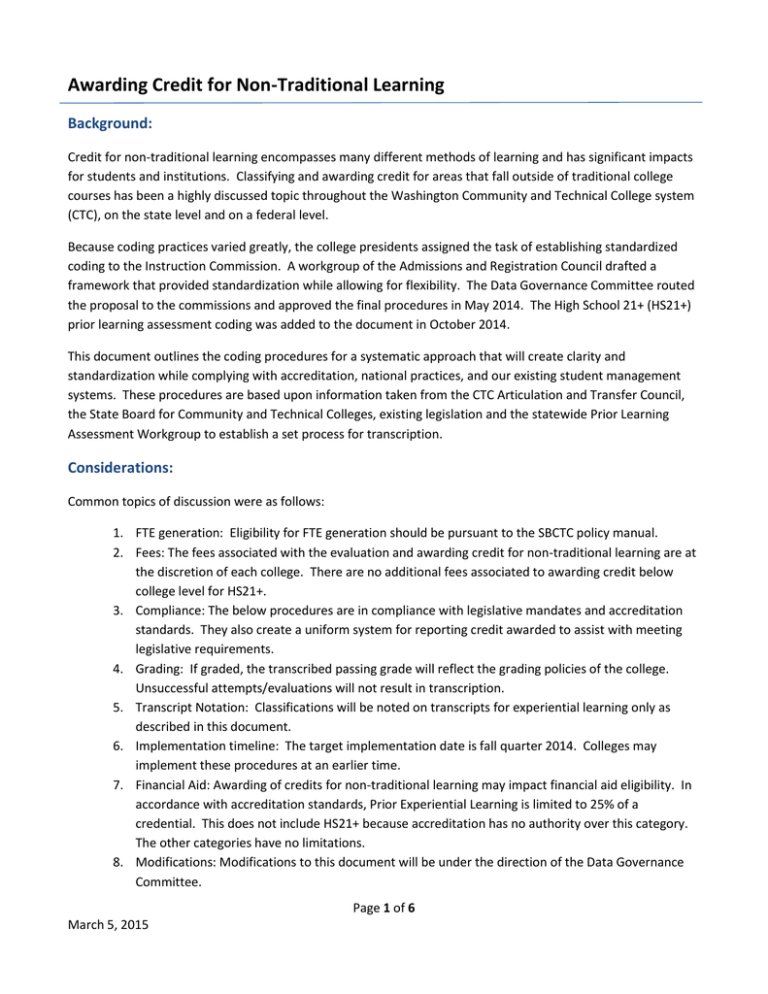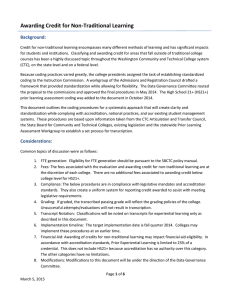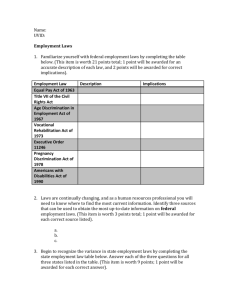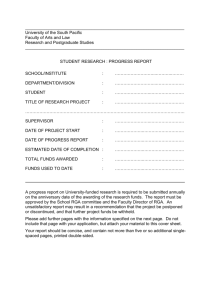Awarding Credit for Non-Traditional Learning Background:
advertisement

Awarding Credit for Non-Traditional Learning Background: Credit for non-traditional learning encompasses many different methods of learning and has significant impacts for students and institutions. Classifying and awarding credit for areas that fall outside of traditional college courses has been a highly discussed topic throughout the Washington Community and Technical College system (CTC), on the state level and on a federal level. Because coding practices varied greatly, the college presidents assigned the task of establishing standardized coding to the Instruction Commission. A workgroup of the Admissions and Registration Council drafted a framework that provided standardization while allowing for flexibility. The Data Governance Committee routed the proposal to the commissions and approved the final procedures in May 2014. The High School 21+ (HS21+) prior learning assessment coding was added to the document in October 2014. This document outlines the coding procedures for a systematic approach that will create clarity and standardization while complying with accreditation, national practices, and our existing student management systems. These procedures are based upon information taken from the CTC Articulation and Transfer Council, the State Board for Community and Technical Colleges, existing legislation and the statewide Prior Learning Assessment Workgroup to establish a set process for transcription. Considerations: Common topics of discussion were as follows: 1. FTE generation: Eligibility for FTE generation should be pursuant to the SBCTC policy manual. 2. Fees: The fees associated with the evaluation and awarding credit for non-traditional learning are at the discretion of each college. There are no additional fees associated to awarding credit below college level for HS21+. 3. Compliance: The below procedures are in compliance with legislative mandates and accreditation standards. They also create a uniform system for reporting credit awarded to assist with meeting legislative requirements. 4. Grading: If graded, the transcribed passing grade will reflect the grading policies of the college. Unsuccessful attempts/evaluations will not result in transcription. 5. Transcript Notation: Classifications will be noted on transcripts for experiential learning only as described in this document. 6. Implementation timeline: The target implementation date is fall quarter 2014. Colleges may implement these procedures at an earlier time. 7. Financial Aid: Awarding of credits for non-traditional learning may impact financial aid eligibility. In accordance with accreditation standards, Prior Experiential Learning is limited to 25% of a credential. This does not include HS21+ because accreditation has no authority over this category. The other categories have no limitations. 8. Modifications: Modifications to this document will be under the direction of the Data Governance Committee. Page 1 of 6 March 5, 2015 Procedure Overview: Credit awarded for non-traditional learning will be transcribed in the year quarter (YRQ/STRM) that it was assessed. Unique codes will be used to assist in tracking and reporting credits awarded for non-traditional learning. In accordance with accreditation standards, credits awarded for prior experiential learning will be differentiated as such on the transcript. There will be situations where credit may be awarded even though the awarding institution does not have a course which is a direct correlation. In these instances, courses will be transcribed under the general category for which they fulfill (ex. Social Science or Psychology). The CTC system will recognize four categories of Credit for Non-Traditional Learning, as follows: 1. Credit by Testing – Commonly accepted higher education equivalency exams that are documented via a transcript or other official record. This category will NOT be noted on transcripts as awarded for prior learning and includes: a. Advanced Placement (AP) b. International Baccalaureate (IB) c. College Level Examination Program (CLEP) d. DANTES Subject Standardized Tests (DSST) e. Cambridge “A” Level Exam 2. Prior Experiential Learning – Knowledge and skills acquired through experience alone, evaluated (subjectively) by faculty via evaluation of a compilation of work. All prior learning assessment HS21+ credits are awarded through prior experiential learning portfolio review. This category WILL be noted on transcripts as awarded for prior learning in accordance with accreditation standards and includes: a. Portfolio Review b. HS21+ Portfolio Review 3. Extra-Institutional Learning – Knowledge and skills acquired outside the institution and objectively verified through third-party certifications, industry-recognized testing/training, crosswalks. This category will NOT be noted on transcripts as awarded for prior learning and includes: a. Individual industry certifications (e.g., NCLEX-RN) b. Occupational Crosswalks (Police, Fire, AmeriCorps, Military, etc.) c. American Council on Education (ACE) Page 2 of 6 March 5, 2015 4. Course Challenges – Challenge examinations are sufficiently comprehensive to determine that the student has the same knowledge and skills as those students who enroll in, and successfully complete, the course. A student should have previous training, private study, work experience, or other bona fide qualifications indicating the student has knowledge or abilities equivalent to course completers. Some course challenges occur prior to enrollment in the course and others are assessed after registration. If the assessment occurs prior to enrollment, the student should not be registered in the course, but be charged a fee and the credit awarded through direct transcription with the corresponding section code as shown below. This category will NOT be noted on transcripts as awarded for prior learning. Legacy Direct Transcription Procedure: When awarding credit for prior learning in the legacy system, use the direct transcription procedure and designated Section code as described below. Credit by Testing o A#P – Advanced Placement (AP) o I#B – International Baccalaureate (IB) o C#P – College Level Examination Program (CLEP) o DST – DANTES Subject Standardized Tests (DSST) o CLE – Cambridge “A” Level Exam Prior Experiential Learning o PEL - Portfolio Review (college level credits) o HSP – HS21+ Portfolio Review (less than college level credits) Extra-Institutional Learning o CRT - Individual industry certifications o OCW - Occupational Crosswalks o ACE – American Council on Education (ACE) Course Challenges o CBE – Credit by Exam Page 3 of 6 March 5, 2015 If equivalent course exists: 1. Instruction approves the awarding of credit. 2. Course information is directly transcribed in screen SM6013. a. Utilize unique section codes, as previously defined (i.e. “A#P”,”PEL”, “OCW”). b. Utilize a valid item number associated to the course in which credits are being granted. (This is for PeopleSoft conversion purposes.) c. If graded, the transcribed PASSING grade will reflect the grading policies of the college. Unsuccessful attempts/evaluations will not result in transcription. d. YRQ awarded is YRQ posted. A specific YRQ is used, not a universal YRQ (Z999). 3. For experiential learning only, notation is made in the transcript comments screen (SM6012) a. Use a specific YRQ , not a universal YRQ (Z999). b. Specific course and source are noted with consistent language (abbreviations will be used as needed) Examples 1. 2. 3. “ENGL&101 awarded from Exp Learning” “CMST&210 awarded for Exp Learning” “ENGL 95 awarded from HS21+ Exp Learning” For course challenges when the student is registered and tuition is charged: a. Create a new section of the class using section code “CBE” b. Enroll the student into this section. c. Grade the student per college grading policy. For course challenges when the student is not registered into the class and a fee is charged, use the above noted direct transcription procedure with a section code of “CBE”. If equivalent course does not exist: 1. Noted as a comment on the transcript. 2. Instruction approves the awarding of credit. 3. Notation is made in the transcript comments (SM6012) a. Specific YRQ is used, not Z999. b. No grade is awarded because it is not an available field. c. Category, credits and source are noted with consistent language. i. Examples 1. 2. 3. 4. 5. 6. “10 credits Soc Science awarded from AP” “10 credits Soc Science awarded from IB” “10 credits Soc Science awarded from CLEP” “10 credits Soc Science awarded from Cambridge” “10 credits Soc Science awarded from Exp Learning” “5 credits Soc Science awarded from HS21+” Page 4 of 6 March 5, 2015 PeopleSoft Campus Solutions Procedure: When awarding credit for prior learning in the PeopleSoft Campus Solutions system, there are four options: o Test Credit (for Credit by Testing) o Other Credit (for Prior Experiential Learning) o Class Enrollment (For Course Challenges) o Transfer-In (for Extra-Institutional Learning) To award credit through Test Credit: 1. On the Test Results Page, enter test scores 2. On the Test Credits – Automated Page, complete the following steps: a. Identify the student’s Academic Program and Plan b. Assign an articulation Term c. Fetch test scores from Test Results Page d. Evaluate the scores e. Accept or deny test credit f. Determine equivalent courses, credit, and grade g. Post-test credits to student’s transcript To award credit through Other Credit: (For Prior Experiential Learning Only) 1. On the Other Credits – Manual Page, complete the following steps: a. Identify the student’s Academic Program and Plan b. Assign an articulation term c. Accept or deny the credit d. Determine equivalent course, credit, and grade For College Level Credits: e. Select “PEL-PR” in the Other Credit Type field. f. Enter “PEL-Portfolio Review [Subject and Catalog Number]” in the Description field. Example: “PEL-Portfolio Review ENGL& 101” g. Post credit to student’s transcript For HS21+: e. Select “PEL-HS” in the Other Credit Type field. f. Enter “PEL-HS 21+ Portfolio Review [Subject and Catalog Number]” in the Description field. Example: “PEL-HS 21+ Portfolio Review ENGL& 090” g. Post credit to student’s transcript Page 5 of 6 March 5, 2015 To award credit through Class Enrollment: 1. If the student is registered and charged tuition: a. Create a new section of the class for course challenge. b. Add a course attribute of “SCBE” to designate this class section as a course challenge. c. Enroll the student in the section. 2. If the student is charged a fee: a. Create a new section of the class for course challenge. b. Set the Class Sub Fees Charge Method to “Not included in term tuition”. c. Add a course attribute of “SNFG” to exclude this class from FTE calculations. d. Add a course attribute of “SCBE” to designate this class section as a course challenge. 3. Grade the student per college grading policy. To award credit through Transfer-In: On the Course Credits Manual Page, complete the following steps for transfer-in credits: 1. 2. 3. 4. 5. Identify the student’s Academic Program Enter the Source Institution information Enter the incoming course and credit information Assign equivalent course, credit, and grade Post credit to transcript Page 6 of 6 March 5, 2015



